A 1D/2D WO3 nanostructure coupled with a nanoparticulate CuO cocatalyst for enhancing solar-driven CO2 photoreduction: the impact of the crystal facet†
Abstract
Photocatalytic reduction of CO2 into solar fuels is regarded as one of the most promising approaches to address the issues of global warming and the energy crisis. The promotion of spatial charge separation and transfer through crystal facet engineering could be conducive to improved photocatalytic activity. In this study, one-dimensional (1D) WO3 nanowires with a {110} dominant facet (WO3-110) and two-dimensional (2D) WO3 nanosheets with a {001} dominant facet (WO3-001) coupled with CuO nanoparticles are fabricated by a facile method and used for CO2 photoreduction. Its composition and structural characterizations suggest that the WO3–CuO hybrid features good contact between the WO3 and CuO nanostructures. Under light irradiation, the WO3 and WO3–CuO nanostructures are able to photoreduce CO2 into CH4. Notably, the prepared WO3–CuO nanohybrids with different exposed facets show improved CO2 reduction capability compared to pure WO3 and CuO. The heterojunction interface between the WO3 photocatalyst and the CuO cocatalyst through p–n contact can facilitate electron–hole pair separation and accordingly results in enhanced photocatalytic performance. With the assistance of the CuO cocatalyst, the {110} facet WO3–CuO hybrid displays superior photoreduction capability compared to the {001} facet WO3–CuO, which is attributed to the difference in the crystal facets in the heterostructure. The {110} facet WO3 nanowires have a more negative conduction band edge, contributing to the higher reduction capacity of this sample. On the other hand, it is shown that faster charge carrier transfer efficiency would enable more photoinduced electrons to participate in CO2 photoreduction, especially with the involvement of the nanoparticulate CuO cocatalyst. This work provides guidance for designing a hetero-photocatalyst–cocatalyst system through crystal facet engineering.



 Please wait while we load your content...
Please wait while we load your content...